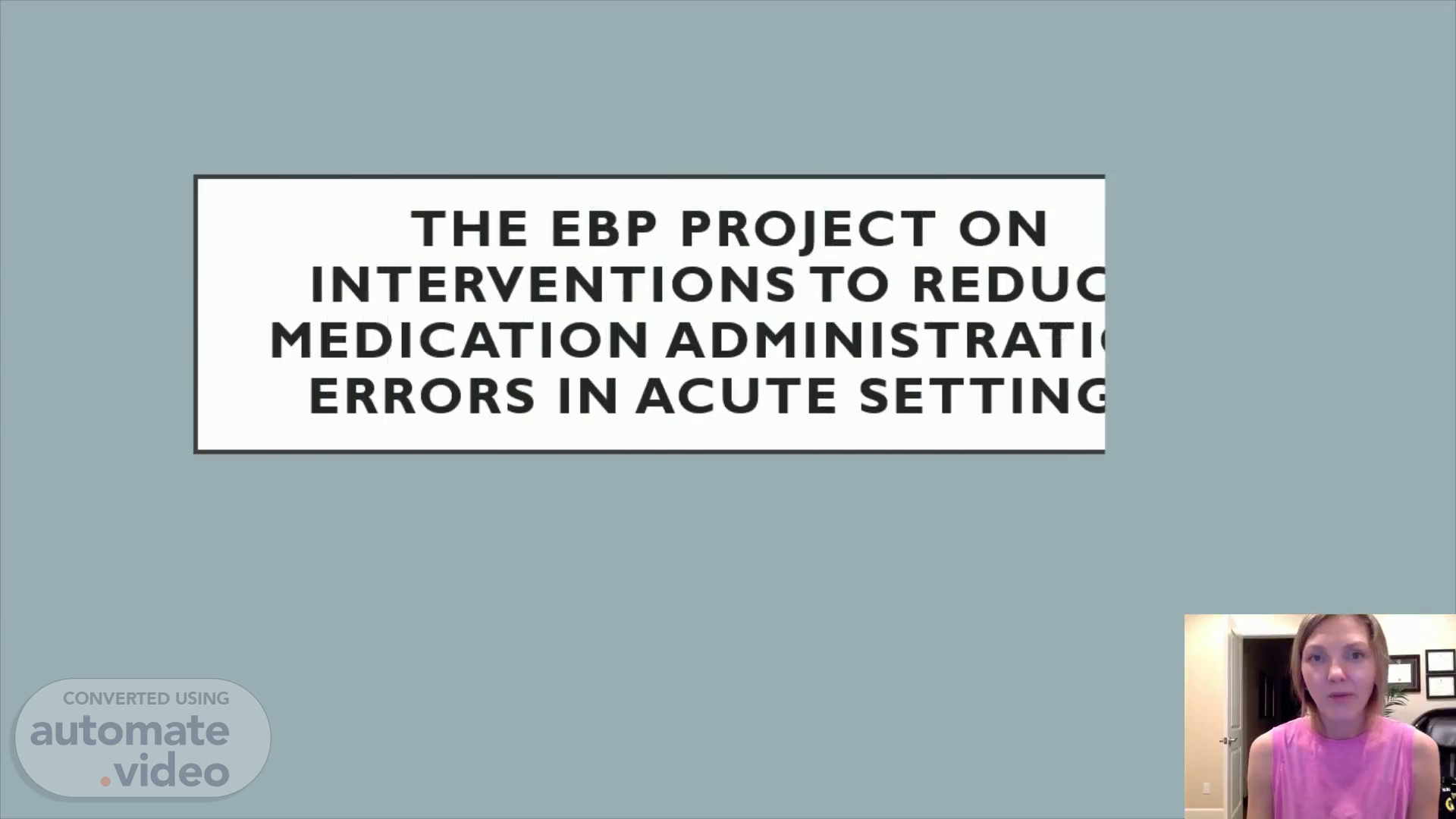
Page 1 (0s)
The EBP Project on Interventions to Reduce Medication Administration Errors in Acute Settings.
Page 2 (15s)
Medication error is a very common problem in hospitals..
Page 3 (1m 6s)
PICO question. In acute settings does the use of additional medication administration tools prevent nurses from being distracted compared to the basic five rights of medication administration decrease medication errors?.
Page 4 (1m 26s)
Databases Evaluation. Ryan Library, PubMed, the CINAHL Database and National Library of Medicine were used to find peer-reviewed articles The databases were found through Point Loma Nazarene University, classmates’ and professors’ recommendations as well as references of the articles with similar topics. The search terms were medication administration, nursing, acute settings, medication errors, nurse interruption, nurse distraction, do not disturb signs, do not interrupt, phone calls, communication with staff members, decreasing medication errors, privacy during medication preparation, preventable medication errors, ways to prevent medication errors. The limiting parameters are publication within the last 5 years, peer-reviewed articles only, level of evidence, English language, full text and open access..
Page 5 (2m 25s)
The EBP project. The goal of this project is to reduce medication administration errors on my floor by 30 % in the next year. The outcome will be measured by reviewing and comparing occurrence reports with the current one, before implementing new methods, and the next year’s one. The interventions : preparing medications in quiet or no interruption zones while wearing a “do not interrupt” tabard or vest and bringing nurses' awareness to the consequences of interruptions and multitasking, especially with attention to those with less experience ( Berdot et al., 2021); simulation-based learning to reduce medication administration errors because it fosters practical and clinical knowledge that improves new nurses' adjustment to practice (Lee, 2019).; and using of an automated drug distribution system with and without electronic medication administration records (Manias et al, 2020)..
Page 6 (3m 35s)
SWOT analysis. The strengths of this project are decreasing the number of medication administration errors, eliminating negative outcomes of medication administration errors including a longer hospital stay, promoting patient safety, and improving hospital status and reputation in the community. The weaknesses of this project are: it is time-consuming, leaving less time for other tasks, nurses will be unavailable during medication administration, and the cost of a medication distribution machine. To address the first two weaknesses, the unit will need to hire a break or resource nurse can help with other tasks..
Page 7 (4m 21s)
Cost-benefit assessment. The cost of the machine will be paid off within a few years because it will contribute to patient safety, bring more clients to the hospital and ensure a reasonable return on investment. The opportunities that this project presents are attracting new clients due to the improved reputation of the hospital, helping retain existing clients, and eliminating the number of lawsuits. The potential threats of this project may be nurses leaving because they will not want to take pharmacology classes, but that can be addressed by offering them to pay for these hours, being short-staffed, and not having resource or break nurses if they call in sick, patients dissatisfaction because they will need to wait longer for their medications, which can be addressed by explaining the process of medication administration during the admission and recommending to call for medications in advance if possible, for example not to wait until the pain is excruciating..
Page 8 (5m 28s)
Key shareholders. The details of the presentation will be discussed with the implementation group after receiving feedback from shareholders: Hospital managers Unit nurses Patients.
Page 9 (5m 42s)
Any issues will be addressed after reviewing occurrence reports and talking with staff members during the meetings with the members of the EBP group after the first month of implementation and then as needed. Data collection will be done by reviewing occurrence reports, the MAR, patient-satisfaction surveys, pharmacists’ reports, physicians’ notes, and the length of hospital stays if medication administration errors take place. If there is a positive outcome within 6 months after implementing the EBP project, then the sustainability of the project will be discussed with supervisors and the manager as well as nurses who would like to be in charge of this project..
Page 10 (6m 33s)
References. Berdot , S., Vilfaillot , A., Bezie , Y., Perrin, G., Berge, M., Corny, J., Thi , T., Depoisson , M., Guihaire , C., Valin, N., Decelle , C., Karras , A., Durieux, P., Lê, L., & Sabatier, B. (2021). Effectiveness of a 'do not interrupt' vest intervention to reduce medication errors during medication administration: a multicenter cluster randomized controlled trial. BMC nursing , 20 (1), 153. https://doi.org/10.1186/s12912-021-00671-7 Lee, H. (2019). A Meta-Analysis of the Effects of interventions on the Prevention of Medication Administration Errors in Nurses. Medico-legal Update 19 (1). Retrieved from https://www.semanticscholar.org/paper/A-Meta-Analysis-of-the-Effects-of-Intervention-on-Lee /5745e021cd9012d4be9bdbc8c065e5988920e309 Manias, E., Kusljic , S., & Wu, A. (2020). Interventions to reduce medication errors in adult medical and surgical settings: a systematic review. Therapeutic advances in drug safety , 11, 2042098620968309. https://doi.org/10.1177/2042098620968309 Panduwal , C. A., & Bilaut , E. C. (2019). The Effectiveness of Interventions to Reduce the Nurses’ Distractions during Medication Administration: A Systematic Review. Jurnal Ners , 14(3), 132–140. https://doi.org/10.20473/jn.v14i3.17048.